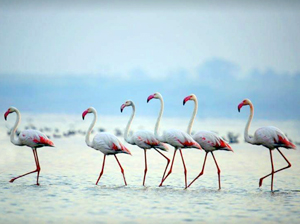Through ceaseless efforts of Bombay Natural History Society, World Wildlife Fund and Forest Department of the Government of Maharashtra, this sanctuary which houses more than 220 species of birds, 400 species of vegetation, 24 species of fish and several smaller mammals came into existence along the Nandur Madhmeshwar dam at the confluence of Godavari and Kadwa. Spread over the protected area of 10000 hectares, lies the core area of 1765 hectares, where the large variety of water birds, resident and migratory birds congregate in season. It is now counted as one of the important water fowl habitats in the region by the International Union of Conservation of Nature.
Location : Niphad Tehsil Of Nashik District, Maharashtra
Known As : Bharathpur Of Maharashtra
Main Attractions : Paradise For Bird Lovers And Watchers
Best Time To Visit : December To March
 Nandur Madhmeshwar Bird Sanctuary is located in Niphad Tehsil of Nashik district in Western Maharashtra. A stone pick up weir was constructed in 1907-13 across the river Godavari just below the confluence of Kodwa and Goadavari rivers at Nandur Madhameshwar. The water level is always fluctuating in Nandur Madhameshwar Lake.
Nandur Madhmeshwar Bird Sanctuary is located in Niphad Tehsil of Nashik district in Western Maharashtra. A stone pick up weir was constructed in 1907-13 across the river Godavari just below the confluence of Kodwa and Goadavari rivers at Nandur Madhameshwar. The water level is always fluctuating in Nandur Madhameshwar Lake.
Th water released from Gangapur and Darana water reservoirs is stored at Nandur Madhameshwar and subsequently released from here through canals for irrigation. Silts and organic matter that are carried away with water flow are accumulated in the lake, due to which islands and shallow water ponds have been created. This resulted in the biological enriched conditions by which aquatic vegetation has been stabilised. Thus the site has turned into good wetland habitat aptly described as ‘Bharatpur Of Maharashtra”.
 Nandur Madhmeshwar Bird Sanctuary is a harbour for thousands of beautiful and migratory birds. There are more than 230 species of birds, out of which 80 are migratory species. The migratory birds found in this sanctuary are White Stork, Glossy Ibis, Spoonbills, Flamigo, Goose Brahminy Duck, Pintails, Mallard, Wigeon, Gargenery Shoveller, Pochardds, Cranes Shanks, Curlews, Pratincole Wagtails, Godwits, Weavers, etc.
Nandur Madhmeshwar Bird Sanctuary is a harbour for thousands of beautiful and migratory birds. There are more than 230 species of birds, out of which 80 are migratory species. The migratory birds found in this sanctuary are White Stork, Glossy Ibis, Spoonbills, Flamigo, Goose Brahminy Duck, Pintails, Mallard, Wigeon, Gargenery Shoveller, Pochardds, Cranes Shanks, Curlews, Pratincole Wagtails, Godwits, Weavers, etc.
The resident birds include Black Ibis, Spot Bills, Teals, Little Grabe, Cormorants, Egrets, Herons, Stork, Kites, Vultures, Buzzards, Harriers, Osprey, Quails, Patridges, Eagles, Water Hens, Sand Pipe, Swifts, Grey hornbill, Peafowl, etc
There are about 460 species of plants, out of which nearly 80 are aquatic plant species. The trees that are found on the outskirts of the lake are Babul, Neem, Tamarind, Jamun, Maharukh, Vilayati Chinch, Mango, Pangara, Nilgiri, etc. The surrounding areas and partly submerged areas are intensively cultivated for wheat, Jowar, Sugarcane, Vegetables etc.
Though this sanctuary is principally a bird sanctuary, many other interesting forms of wildlife can also be spotted over here. The animals spotted here are Ottar, Palm Civet, Fishing Cat, Jackal, Mangoose, Wolves and many species of Snakes, etc. Nearly 24 species of fishes have been recorded in the reservoir.
The area has many temples in the vicinity. The water reservoir when filled in with water gives panoramic view of the surrounding and its fascinating fauna attracts the visitors through out the year.
Air : Nearest Airport is in Aurangabad at 180-km from the sanctuary.
Rail : Nearest railway station is Niphad a small station at 12-km on Mumbai-Bhusaval railway line.
Road : The sanctuary is easily approachable by road either via Niphad, Nashik and Sinnar.
More info Ref: http://wildlife-tours.tourtravelworld.com ![]()